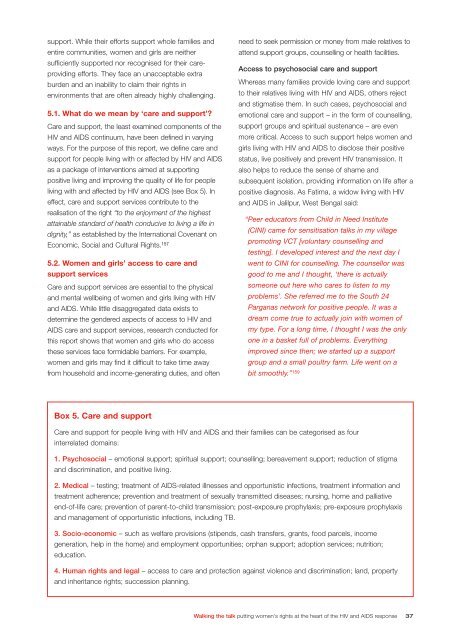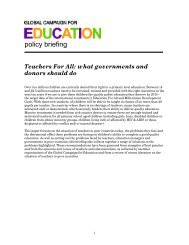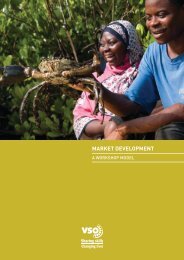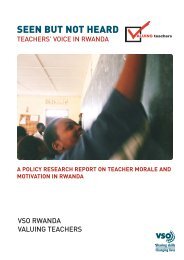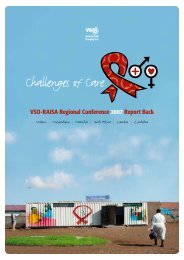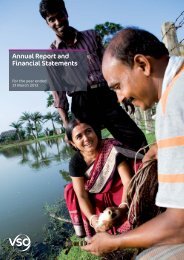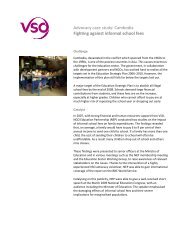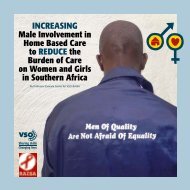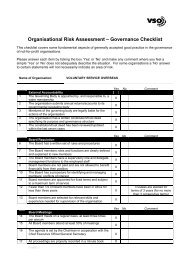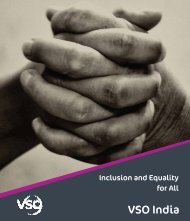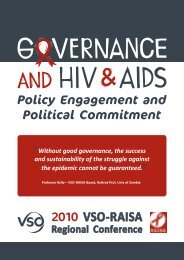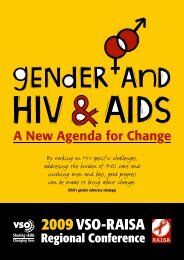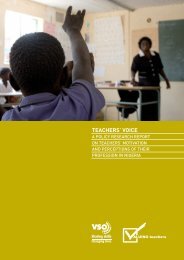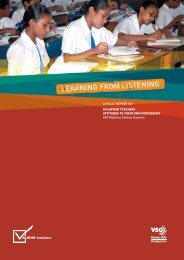Walking the Talk - VSO
Walking the Talk - VSO
Walking the Talk - VSO
Create successful ePaper yourself
Turn your PDF publications into a flip-book with our unique Google optimized e-Paper software.
support. While <strong>the</strong>ir efforts support whole families andentire communities, women and girls are nei<strong>the</strong>rsufficiently supported nor recognised for <strong>the</strong>ir careprovidingefforts. They face an unacceptable extraburden and an inability to claim <strong>the</strong>ir rights inenvironments that are often already highly challenging.5.1. What do we mean by ‘care and support’?Care and support, <strong>the</strong> least examined components of <strong>the</strong>HIV and AIDS continuum, have been defined in varyingways. For <strong>the</strong> purpose of this report, we define care andsupport for people living with or affected by HIV and AIDSas a package of interventions aimed at supportingpositive living and improving <strong>the</strong> quality of life for peopleliving with and affected by HIV and AIDS (see Box 5). Ineffect, care and support services contribute to <strong>the</strong>realisation of <strong>the</strong> right “to <strong>the</strong> enjoyment of <strong>the</strong> highestattainable standard of health conducive to living a life indignity,” as established by <strong>the</strong> International Covenant onEconomic, Social and Cultural Rights. 1575.2. Women and girls’ access to care andsupport servicesCare and support services are essential to <strong>the</strong> physicaland mental wellbeing of women and girls living with HIVand AIDS. While little disaggregated data exists todetermine <strong>the</strong> gendered aspects of access to HIV andAIDS care and support services, research conducted forthis report shows that women and girls who do access<strong>the</strong>se services face formidable barriers. For example,women and girls may find it difficult to take time awayfrom household and income-generating duties, and oftenneed to seek permission or money from male relatives toattend support groups, counselling or health facilities.Access to psychosocial care and supportWhereas many families provide loving care and supportto <strong>the</strong>ir relatives living with HIV and AIDS, o<strong>the</strong>rs rejectand stigmatise <strong>the</strong>m. In such cases, psychosocial andemotional care and support – in <strong>the</strong> form of counselling,support groups and spiritual sustenance – are evenmore critical. Access to such support helps women andgirls living with HIV and AIDS to disclose <strong>the</strong>ir positivestatus, live positively and prevent HIV transmission. Italso helps to reduce <strong>the</strong> sense of shame andsubsequent isolation, providing information on life after apositive diagnosis. As Fatima, a widow living with HIVand AIDS in Jalilpur, West Bengal said:“Peer educators from Child in Need Institute(CINI) came for sensitisation talks in my villagepromoting VCT [voluntary counselling andtesting]. I developed interest and <strong>the</strong> next day Iwent to CINI for counselling. The counsellor wasgood to me and I thought, ‘<strong>the</strong>re is actuallysomeone out here who cares to listen to myproblems’. She referred me to <strong>the</strong> South 24Parganas network for positive people. It was adream come true to actually join with women ofmy type. For a long time, I thought I was <strong>the</strong> onlyone in a basket full of problems. Everythingimproved since <strong>the</strong>n; we started up a supportgroup and a small poultry farm. Life went on abit smoothly.” 159Box 5. Care and supportCare and support for people living with HIV and AIDS and <strong>the</strong>ir families can be categorised as fourinterrelated domains:1. Psychosocial – emotional support; spiritual support; counselling; bereavement support; reduction of stigmaand discrimination, and positive living.2. Medical – testing; treatment of AIDS-related illnesses and opportunistic infections, treatment information andtreatment adherence; prevention and treatment of sexually transmitted diseases; nursing, home and palliativeend-of-life care; prevention of parent-to-child transmission; post-exposure prophylaxis; pre-exposure prophylaxisand management of opportunistic infections, including TB.3. Socio-economic – such as welfare provisions (stipends, cash transfers, grants, food parcels, incomegeneration, help in <strong>the</strong> home) and employment opportunities; orphan support; adoption services; nutrition;education.4. Human rights and legal – access to care and protection against violence and discrimination; land, propertyand inheritance rights; succession planning.<strong>Walking</strong> <strong>the</strong> talk putting women's rights at <strong>the</strong> heart of <strong>the</strong> HIV and AIDS response 37


